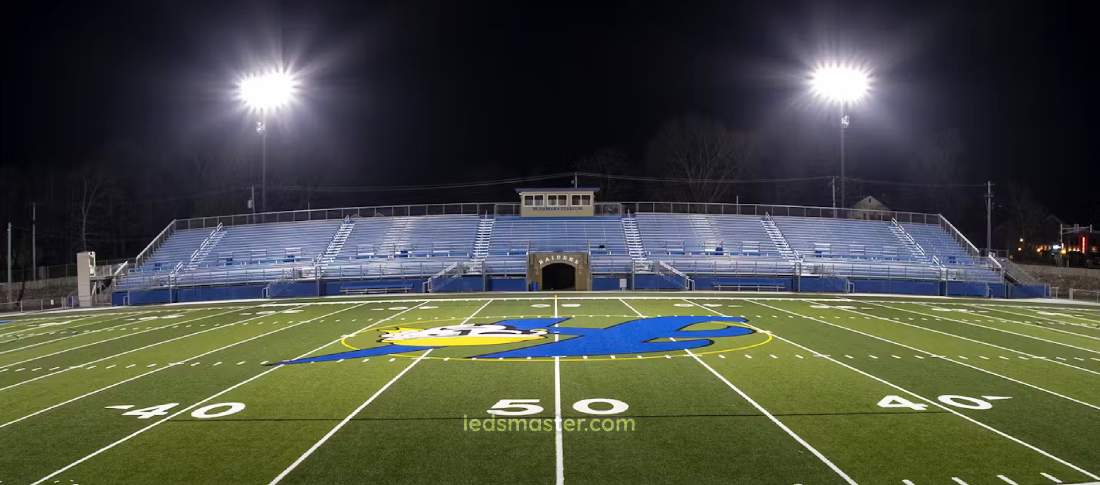
By incorporating LED lighting, we can create systems that provide consistent illumination while promoting energy efficiency and sustainability in football fields.
Get your complimentary lighting design today
The design of football field lighting involves numerous factors, including lighting requirements, uniformity, the number of lights, and specific design methodologies. With advancements in technology, particularly with the use of LED lighting, modern football fields can achieve optimal illumination, enhancing both play and viewer experience.
Table of Contents
ToggleThe primary objective of football field lighting is to provide adequate illumination for both daytime and nighttime games. Proper lighting is essential not only for the safety and performance of players but also for enhancing the overall viewing experience for spectators. Well-designed lighting ensures that players can clearly see the ball, their teammates, and the field markings, which is crucial for effective gameplay. Additionally, adequate illumination contributes to reducing the likelihood of injuries, as players are less likely to encounter shadows that obscure their vision. For spectators, high-quality lighting enhances visibility, allowing them to enjoy the game without straining their eyes, whether they are in the stands or watching on television.
The lighting levels required for football fields vary significantly depending on the level of play and the type of events being hosted. For recreational leagues, which typically include youth and amateur games, the illumination needs are more modest. Generally, these fields require about 100 to 150 lux for practice sessions, ensuring that players have sufficient light to play safely without the need for high-intensity lighting. In contrast, professional games demand much higher illumination levels to meet stringent visibility requirements. According to the Illuminating Engineering Society (IES), competitive games usually require illumination levels ranging from 300 to 500 lux, which supports better visibility for players and officials. For televised matches, the standards rise even further, with lux requirements often exceeding 800. This ensures that cameras can capture every detail of the game, providing clear images for viewers at home and maintaining high production values.

Inadequate or uneven lighting can lead to shadows and dark spots that not only disrupt players’ focus but also increase the risk of injury during play. When some areas of the field are poorly lit, players may struggle to judge distances and react quickly to dynamic situations, which can lead to accidents on the field. Uniform lighting, therefore, ensures that all sections of the field are adequately illuminated, fostering a safer environment and enhancing the overall quality of the game. By minimizing discrepancies in brightness, uniform lighting promotes better performance, allowing players to concentrate on their game rather than on their surroundings.
The uniformity ratio is defined as the ratio of the minimum to the average illuminance across the playing surface. This ratio is essential for ensuring that light is distributed evenly throughout the field. For training fields, the ideal uniformity ratio should be above 0.6, indicating that even the least illuminated areas receive a substantial amount of light relative to the average. For competition fields, this standard rises to at least 0.75, emphasizing the importance of consistent lighting in high-stakes environments. Achieving these uniformity ratios means that every section of the field must receive consistent illumination, effectively minimizing any dark spots or overly bright areas that could disrupt play. This attention to detail in lighting design not only supports player performance but also contributes to the integrity of the game, ensuring that athletes can compete under fair and predictable conditions.
Calculating the number of lights needed for a football field requires a detailed understanding of both the light output of the fixtures being used and the specific layout of the field. LEDs are particularly advantageous in this context, as they offer high luminous efficacy and longer lifespans compared to traditional lighting solutions.
To estimate the number of fixtures required, it is essential to consider the field’s dimensions, the desired lux level, and the individual light output of the selected LED fixtures. For example, if a football field requires an average of 300,000 lumens and each LED fixture produces 30,000 lumens, approximately ten fixtures would be needed. However, this number can vary based on fixture placement and the specific design strategy employed.
Designing effective lighting for a football field involves several steps. Initially, lighting designers must assess the field’s dimensions and the specific needs based on usage patterns. Factors such as the angle of play, spectator areas, and broadcast requirements must also be considered to ensure comprehensive coverage.
The design process typically starts with a photometric analysis, which uses computer simulations to model how light will interact with the field’s surface. This analysis helps identify optimal fixture placement and the best type of light to use, ensuring both adequate brightness and uniformity.
When using LED lighting, designers should take advantage of its directional nature. LEDs emit light in a specific direction, reducing light pollution and enhancing efficiency. The installation of LED fixtures can be strategically placed around the perimeter of the field, focusing on angles that maximize light coverage while minimizing glare for players and officials.
Several key factors influence the design of lighting for football fields, starting with geographical location and environmental conditions. Fields situated in areas with significant seasonal variations may require fixtures designed to withstand extreme weather. This is crucial for ensuring consistent performance throughout the year, regardless of temperature fluctuations, precipitation, or other environmental challenges. Selecting durable lighting fixtures that can endure harsh conditions helps maintain safety and functionality for players and spectators alike.
Another significant factor affecting lighting design is the level of play. Different levels of competition impose varying requirements on lighting systems. For instance, high school fields may have less stringent lighting needs compared to professional stadiums, which are often subject to strict guidelines, especially for televised events. Understanding the intended use of the field is essential in creating an effective lighting system that meets the specific demands of its users. This includes considerations for illumination levels, uniformity, and overall design to ensure optimal visibility during games.
In recent years, energy efficiency and sustainability considerations have become increasingly important in the design of football field lighting. LED lighting has emerged as a preferred option due to its excellent illumination capabilities, reduced energy consumption, and lower maintenance costs. By incorporating LEDs into modern football field lighting designs, facilities can significantly lower their environmental impact while also benefiting economically. This dual advantage makes LEDs an ideal choice for football field lighting, aligning with the broader push toward sustainable practices in sports facilities.
Once the design phase is complete, the next step involves the installation of the lighting system. Proper installation is critical for ensuring that the fixtures provide the intended illumination. It is essential to follow manufacturer guidelines closely and to ensure that fixtures are mounted securely at the correct heights and angles.
Regular maintenance is also vital to the longevity and performance of the lighting system. Scheduled inspections can help identify any issues early on, ensuring that any dimming or malfunctioning fixtures are promptly replaced or repaired. This ongoing maintenance is crucial for maintaining consistent lighting levels and ensuring the safety of players and spectators.
The design of football field lighting is a multifaceted process that requires careful consideration of various factors, including lighting requirements, uniformity, the number of lights, and design strategies. The transition to LED technology has transformed the landscape of sports lighting, providing energy-efficient solutions that meet the demands of modern play and spectator experience. By focusing on these essential elements, football field lighting can ensure safety, enhance performance, and create an engaging atmosphere for players and fans alike. With ongoing advancements in technology, the future of football field lighting holds exciting possibilities for even greater efficiency and effectiveness.